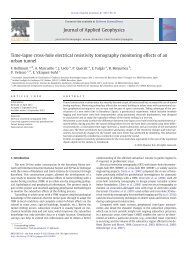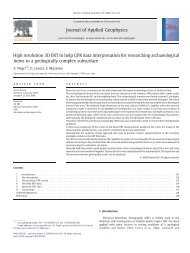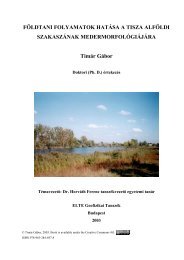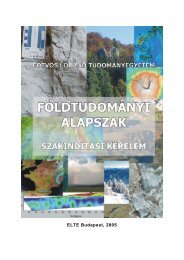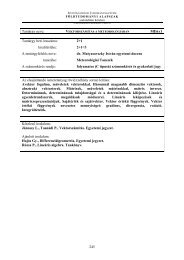Qualitative interpretation of Bouguer anomaly in the southern part of ...
Qualitative interpretation of Bouguer anomaly in the southern part of ...
Qualitative interpretation of Bouguer anomaly in the southern part of ...
You also want an ePaper? Increase the reach of your titles
YUMPU automatically turns print PDFs into web optimized ePapers that Google loves.
Geosciences Journal<br />
Vol. 3, No. 1, p. 49-54, March 1999<br />
<strong>Qualitative</strong> <strong><strong>in</strong>terpretation</strong> <strong>of</strong> <strong>Bouguer</strong> <strong>anomaly</strong> <strong>in</strong> <strong>the</strong> sou<strong>the</strong>rn <strong>part</strong><br />
<strong>of</strong> <strong>the</strong> Korean pen<strong>in</strong>sula<br />
Kwang Sun Choi<br />
G.V.R. Kumar<br />
Ki Young Kim<br />
De<strong>part</strong>ment <strong>of</strong> Earth Science Education, Pusan National University, Pusan 609-735, Korea<br />
(e-mail: ksunchoi@hyowon.pusan.ac.kr)<br />
Oil & Natural Gas Corporation Limited, Chennai 600-008, India (e-mail: svbalu@giasmda.vsnl.net.<strong>in</strong>)<br />
De<strong>part</strong>ment <strong>of</strong> Geophysics, Kangwon National University, Chunchon 200-701, Korea<br />
(e-mail: kykim@cc.kangwon.ac.kr)<br />
ABSTRACT: Regional gravity <strong>anomaly</strong> maps <strong>of</strong> Korea have<br />
been used for geologic <strong>in</strong>formation on <strong>the</strong> nature <strong>of</strong> crust and<br />
isostasy. We made an attempt to <strong>in</strong>terpret <strong>the</strong> <strong>Bouguer</strong> map<br />
based on <strong>the</strong> nature, quality, and characteristics <strong>of</strong> anomalies<br />
and <strong>in</strong>tegrate <strong>the</strong> data with <strong>the</strong> geologic and tectonic features.<br />
Seismicity is also considered for <strong>the</strong> correlation with <strong>the</strong><br />
<strong>Bouguer</strong> map. It reveals that <strong>the</strong> gravity <strong>anomaly</strong> map helps<br />
del<strong>in</strong>eate major tectonic boundaries. It is observed that <strong>the</strong><br />
gravity high zones are associated with earthquake activity and<br />
l<strong>in</strong>eaments <strong>in</strong> <strong>the</strong>ir proximity.<br />
Key words: <strong>Bouguer</strong> <strong>anomaly</strong>, tectonic boundary, seismicity<br />
1. INTRODUCTION<br />
Gravity methods are used for <strong>the</strong> analysis <strong>of</strong> geologic<br />
structures and evolution <strong>of</strong> <strong>the</strong> earth's crust. Though<br />
detailed surveys are always advantageous, most <strong>of</strong> <strong>the</strong><br />
objectives <strong>in</strong>itially require a broad and regional approach<br />
to establish <strong>the</strong> basic scientific framework. Regional<br />
gravity <strong>anomaly</strong> maps are <strong>part</strong>icularly useful for mapp<strong>in</strong>g<br />
geographic distribution and configuration <strong>of</strong> <strong>the</strong> basement<br />
rocks, structural and lithologic prov<strong>in</strong>ces, zones <strong>of</strong> crustal<br />
weakness, mass imbalances with<strong>in</strong> <strong>the</strong> lithosphere, geometrical<br />
configuration <strong>of</strong> sedimentary bas<strong>in</strong>s, and <strong>the</strong><br />
distribution <strong>of</strong> extrusive and <strong>in</strong>trusive rocks.<br />
In Korea, gravity data were first measured us<strong>in</strong>g a<br />
pendulum <strong>in</strong> 1927 (Kumagai, 1953). Regional gravity<br />
surveys have been carried out us<strong>in</strong>g modem gravimeters<br />
s<strong>in</strong>ce late 1950s (Woollard and Rose, 1963). An updated<br />
<strong>Bouguer</strong> <strong>anomaly</strong> map has been compiled by Choi and<br />
Sh<strong>in</strong> (1996) us<strong>in</strong>g gravity measurements at more than<br />
5000 stations <strong>in</strong> <strong>the</strong> sou<strong>the</strong>rn <strong>part</strong> <strong>of</strong> <strong>the</strong> Korean pen<strong>in</strong>sula<br />
(Fig. 1). For gridd<strong>in</strong>g <strong>the</strong> data, gravity data <strong>of</strong> Fukuda (1990)<br />
are used <strong>in</strong> <strong>the</strong> East Sea and OSU91A <strong>in</strong> <strong>the</strong> nor<strong>the</strong>rn <strong>part</strong><br />
<strong>of</strong> <strong>the</strong> pen<strong>in</strong>sula (Choi et al., 1993). It was concentrated <strong>in</strong><br />
fill<strong>in</strong>g <strong>the</strong> gap and merg<strong>in</strong>g new observations with exist<strong>in</strong>g<br />
gravity data and prepared a new version. The gravity<br />
measurements have been reduced to mean sea level us<strong>in</strong>g a<br />
<strong>Bouguer</strong> density <strong>of</strong> 2.67 gm/cc. Terra<strong>in</strong> effects have been<br />
corrected at each station for 100 x 100 knq 2 <strong>in</strong> area.<br />
The <strong>Bouguer</strong> <strong>anomaly</strong> map (Fig. 1) with a contour<br />
<strong>in</strong>terval <strong>of</strong> 5 mGal shows several dist<strong>in</strong>ctive features <strong>of</strong><br />
gravity <strong>anomaly</strong> <strong>in</strong> <strong>the</strong> sou<strong>the</strong>rn <strong>part</strong> <strong>of</strong> <strong>the</strong> Korean<br />
pen<strong>in</strong>sula. The major gravity lows from this map are<br />
ascribed to Sobaeksan (S) area and Kangwon-do (K)<br />
prov<strong>in</strong>ce, respectively. The large l<strong>in</strong>ear gravity trend with<br />
a maximum value <strong>of</strong> 60 mGal <strong>in</strong> <strong>the</strong> <strong>of</strong>fshore is due to<br />
dim<strong>in</strong>ish<strong>in</strong>g depth <strong>of</strong> crust (Choi, 1988). He also<br />
prepared a residual <strong>anomaly</strong> map and found that negative<br />
anomalies co<strong>in</strong>cide well with <strong>the</strong> granitic and volcanic<br />
areas, as <strong>the</strong> density <strong>of</strong> <strong>the</strong>se rocks is comparatively less<br />
than that <strong>of</strong> <strong>the</strong> Precambrian gneiss. Lee (1979) used<br />
<strong>Bouguer</strong> anomalies to calculate <strong>the</strong> depth to <strong>the</strong> Moho<br />
and his studies <strong>in</strong>dicate that <strong>the</strong> Korean pen<strong>in</strong>sula is<br />
almost <strong>in</strong> isostatic equilibrium and <strong>the</strong> mean crustal<br />
thickness is about 35 km. On <strong>the</strong> o<strong>the</strong>r hand, Kwon and<br />
Yang (1985) <strong>in</strong>dicated from <strong>the</strong>ir studies through l<strong>in</strong>ear<br />
regression that <strong>the</strong> crust <strong>of</strong> <strong>the</strong> Korean pen<strong>in</strong>sula seems<br />
not to be <strong>in</strong> perfect equilibrium but slightly undercompensated.<br />
Choi et al. (1993) analysed gravity data and<br />
deciphered that <strong>the</strong> crustal thickness <strong>in</strong> and around Korea<br />
is on <strong>the</strong> order <strong>of</strong> 16 to 41 km. Kyung (1989) studied <strong>the</strong><br />
relation between <strong>the</strong> topography and <strong>the</strong> seismicity <strong>of</strong> <strong>the</strong><br />
Korean pen<strong>in</strong>sula. He also observed that <strong>the</strong> epicenters <strong>of</strong><br />
earthquakes are distributed dom<strong>in</strong>antly along <strong>the</strong> areas <strong>of</strong><br />
high gradient <strong>of</strong> <strong>Bouguer</strong> and residual anomalies. Many<br />
researchers have utilized <strong>the</strong> <strong>Bouguer</strong> <strong>anomaly</strong> map for<br />
<strong>the</strong> nature <strong>of</strong> <strong>the</strong> crust and isostasy. None<strong>the</strong>less, a<br />
complete description <strong>of</strong> <strong>Bouguer</strong> <strong>anomaly</strong> <strong><strong>in</strong>terpretation</strong><br />
is not available <strong>in</strong> <strong>the</strong> previous works, <strong>in</strong> concordance<br />
with <strong>the</strong> regional geology.<br />
2. QUALITATIVE INTERPRETATION OF<br />
BOUGUER ANOMALY MAP<br />
2.1. General Features<br />
The <strong>Bouguer</strong> <strong>anomaly</strong> map presents many closures
50 Kwang Sun Choi, G.V.R. Kumar, and Ki Young Kim<br />
Fig. 1. Regioal <strong>Bouguer</strong> <strong>anomaly</strong> map <strong>in</strong> <strong>the</strong> sou<strong>the</strong>rn <strong>part</strong> <strong>of</strong> Korean pen<strong>in</strong>sula. Contour <strong>in</strong>terval is 5 mGal. This map presents<br />
many closures around gravity 'highs' and 'lows'. The iso<strong>anomaly</strong> l<strong>in</strong>es follow a NNE-SSW trend and are <strong>in</strong> accordance with <strong>the</strong><br />
general geologic strike <strong>of</strong> Korea.<br />
around gravity 'highs' and 'lows'. Some <strong>of</strong> <strong>the</strong> <strong>Bouguer</strong><br />
anomalies do not appear to have been caused by surface<br />
geology. The iso<strong>anomaly</strong> l<strong>in</strong>es <strong>in</strong> <strong>the</strong> map generally<br />
follow a NNE-SSW trend and are <strong>in</strong> accordance with <strong>the</strong><br />
general geologic l<strong>in</strong>eament <strong>of</strong> Korea.<br />
A gravity low with a magnitude <strong>of</strong> -25 reGal and NE-<br />
SW direction is seen near south <strong>of</strong> Taejon. This low<br />
appears to be caused by a downwarp <strong>in</strong> <strong>the</strong> basement and<br />
can be attributed to <strong>the</strong> crustal thicken<strong>in</strong>g. As <strong>the</strong> density<br />
<strong>of</strong> granites is less than <strong>the</strong> Precambrian rocks <strong>of</strong> <strong>the</strong><br />
surround<strong>in</strong>g area, <strong>the</strong> huge thickness <strong>of</strong> <strong>the</strong>se granites<br />
gives rise to a low gravity <strong>anomaly</strong>. This explanation<br />
corroborates with <strong>the</strong> geological explanation <strong>of</strong> Sobaeksan<br />
massif <strong>in</strong> this area. The sou<strong>the</strong>astern <strong>part</strong> <strong>of</strong> this low<br />
is faulted as <strong>the</strong> contours show a steep gradient with its<br />
downthrown side sou<strong>the</strong>astwards. Northwestern and western<br />
sides <strong>of</strong> this low are represented by disturbed pattern <strong>of</strong><br />
<strong>anomaly</strong> contours. There might be a possibility for extrusive/<br />
<strong>in</strong>trusive activity <strong>in</strong> <strong>the</strong>se areas caus<strong>in</strong>g localized density<br />
variations.<br />
A gravity low with a magnitude <strong>of</strong> -20 reGal with its<br />
strike (almost NE-SW) is noticed near sou<strong>the</strong>ast <strong>of</strong>
Interpretation <strong>of</strong> <strong>Bouguer</strong> <strong>anomaly</strong> <strong>in</strong> Korea 51<br />
Chunchon. This low is most likely due to <strong>the</strong> granitic<br />
<strong>in</strong>trusion <strong>in</strong> <strong>the</strong> Precambrian basement. Although <strong>the</strong><br />
gravity anomalies <strong>in</strong> <strong>the</strong> above two major gravity lows<br />
show a little resemblance <strong>in</strong> <strong>the</strong>ir magnitude and strike<br />
direction, it is not possible to make any genetic relation<br />
between <strong>the</strong>se gravity lows because <strong>the</strong>y could have been<br />
formed at different geologic times.<br />
In <strong>the</strong> sou<strong>the</strong>astern <strong>part</strong>, <strong>in</strong> <strong>the</strong> proximity <strong>of</strong> Taegu,<br />
pairs <strong>of</strong> gravity lows and highs are observed. Although<br />
<strong>the</strong>se are <strong>of</strong> low-relief, <strong>the</strong> highs can be attributed to<br />
volcanic or sedimentary rocks <strong>of</strong> low porosity and <strong>the</strong><br />
lows to granites or Tertiary sediments. The average<br />
values <strong>of</strong> density for low-porosity sedimentary rocks,<br />
basalts, andesites, granites, and Tertiary sediments are<br />
2.60, 2.90, 2.61, 2.55, and 2.03, respectively (M<strong>in</strong> and<br />
Chung, 1985).<br />
Around Seoul, a very varied nature <strong>of</strong> gravity <strong>anomaly</strong><br />
pattern hav<strong>in</strong>g small and large amplitudes suggests that<br />
<strong>the</strong> area comprises metamorphic terra<strong>in</strong> with rocks <strong>of</strong><br />
different densities.<br />
A broad zone along <strong>the</strong> east coast with seaward<br />
gradient close to 10 mGal/km trends N-S upto latitude<br />
36~ and <strong>the</strong>n NW-SE which reflects <strong>the</strong> <strong>of</strong>fshore<br />
transition <strong>of</strong> cont<strong>in</strong>ental crust. The gradual <strong>in</strong>crease <strong>in</strong><br />
magnitude <strong>of</strong> <strong>Bouguer</strong> anomalies <strong>in</strong>dicates a gradual<br />
decrease <strong>in</strong> thickness <strong>of</strong> <strong>the</strong> crust. The attitude <strong>of</strong> this<br />
flock <strong>of</strong> contours trend<strong>in</strong>g N-S direction and hav<strong>in</strong>g<br />
<strong>in</strong>creased values towards <strong>the</strong> coast also suggests that<br />
<strong>the</strong>re exists a fault along <strong>the</strong> eastern side <strong>of</strong> <strong>the</strong> east<br />
coast.<br />
There are many locations <strong>in</strong> <strong>the</strong> sou<strong>the</strong>ast, nor<strong>the</strong>ast,<br />
and south-central <strong>part</strong>s <strong>of</strong> Korea where dislocations <strong>of</strong><br />
<strong>the</strong> narrow belts <strong>of</strong> high gradients are observed. These<br />
dislocations can be <strong>in</strong>terpreted as orig<strong>in</strong>at<strong>in</strong>g from some<br />
major or m<strong>in</strong>or strike-slip faults with horizontal movements.<br />
Some <strong>of</strong> <strong>the</strong> prom<strong>in</strong>ent faults <strong>in</strong>clud<strong>in</strong>g Yongduri<br />
(F1), Andong (F3), and Yangsan (F4) faults have been<br />
marked with <strong>the</strong> help <strong>of</strong> typical nature <strong>of</strong> <strong>the</strong> gravity<br />
contours that associate with <strong>the</strong> fault<strong>in</strong>g (Fig. 2). The<br />
fault F2 appears as an assumed one on <strong>the</strong> geologic map<br />
<strong>of</strong> 1:1,000,000 scale (Korea Institute <strong>of</strong> Geology, M<strong>in</strong><strong>in</strong>g<br />
and Materials, 1995), whereas F3 has no surface <strong>in</strong>dication.<br />
2.2. Zon<strong>in</strong>g<br />
After qualitatively analys<strong>in</strong>g <strong>the</strong> <strong>Bouguer</strong> <strong>anomaly</strong> map<br />
<strong>in</strong> terms <strong>of</strong> gravity lows, highs, and l<strong>in</strong>ear trends for<br />
possible explanation <strong>of</strong> subsurface causatives, zon<strong>in</strong>g is<br />
<strong>in</strong>troduced on <strong>the</strong> basis <strong>of</strong> nature, pattern and characteristics<br />
<strong>of</strong> gravity anomalies to describe various tectonic<br />
boundaries (Fig. 2). Seven zones have been clearly<br />
identified. The description <strong>of</strong> each zone is provided<br />
hereunder.<br />
2.2.1. Kyonggi massif zone (Z1)<br />
This zone is characterized by irregular pattern <strong>of</strong><br />
contours, relative lows and highs with small relief,<br />
trend<strong>in</strong>g NNE-SSW. Precambrian rocks associated with<br />
granites as <strong>in</strong>trusives and extrusives at some places are<br />
<strong>the</strong> geological manifestations <strong>of</strong> <strong>the</strong> gravity signatures.<br />
The zone may conta<strong>in</strong> small and complex m<strong>in</strong>or fold<br />
structures at places because <strong>of</strong> <strong>the</strong> <strong>in</strong>trusive activity.<br />
2.2.2. Nonmetamorphic zone (Z2)<br />
This zone is characterized by long wavelength anomalies,<br />
low ampfitude but large relief and trends NNE-SSW.<br />
Jurassic granites <strong>in</strong> this area give rise to this type <strong>of</strong><br />
<strong>anomaly</strong> deportment.<br />
2.2.3. Okchon belt zone (Z3)<br />
This zone shows narrow anomalies <strong>of</strong> moderate amplitude.<br />
It comprises ma<strong>in</strong>ly metamorphic rocks and trends<br />
NNE-SSW.<br />
2.2.4. Taebacksan zone (Z4)<br />
This zone is characterized by a low gravity <strong>anomaly</strong> <strong>of</strong><br />
<strong>the</strong> order <strong>of</strong> -20 mGal. This low trends NE-SW with<br />
small lows and highs. The Triassic granites with low<br />
density are most likely responsible for <strong>the</strong> low values.<br />
2.2.5. Sobaeksan zone (Z5)<br />
This zone is characterized by large wavelength, very<br />
low amplitude with high relief and trends NNE-SSW.<br />
Massive granitic <strong>in</strong>trusion attests to <strong>the</strong> gravity signatures.<br />
2.2.6. Kyongsang Bas<strong>in</strong> (Z6)<br />
This zone is classified as many separated lows and<br />
highs with small magnitude and no <strong>part</strong>icular trend. These<br />
lows are expla<strong>in</strong>ed due to low-density Bulguksa granites<br />
and <strong>the</strong> highs to sedimentary rocks <strong>of</strong> <strong>the</strong> Cretaceous.<br />
2.2.7. Yongdong-Kwangju depression zone (Z7)<br />
This zone is <strong>of</strong> high magnitude with a large range and<br />
no <strong>part</strong>icular trend. Cretaceous cont<strong>in</strong>ental sediments and<br />
volcanic rocks are responsible for <strong>the</strong> gravity anomalies.<br />
3. SEISMICITY<br />
Earthquakes <strong>in</strong> Korea are classified as <strong>in</strong>traplate<br />
seismicity (Lee and Na, 1983). Figure 3 shows epicenters<br />
<strong>of</strong> both historical and <strong>in</strong>strumental earthquakes hav<strong>in</strong>g<br />
<strong>in</strong>tensity equal to or more than V, which occurred <strong>in</strong><br />
Korea from A.D. 2 to 1987. It is apparent that higher<br />
seismicity is associated with many <strong>of</strong> <strong>the</strong> faults and<br />
tectonic boundaries. Most seismic activities appear to be<br />
associated with <strong>the</strong> gravity-high zones and are conf<strong>in</strong>ed<br />
to <strong>the</strong> tectonic boundaries. Evidently, <strong>the</strong> gravity lows and<br />
highs are form<strong>in</strong>g pairs at many places and are separated by
52 Kwang Sun Choi, G.V.R. Kumar, and Ki Young Kim<br />
Fig. 2. Zon<strong>in</strong>g map <strong>of</strong> <strong>Bouguer</strong> <strong>anomaly</strong>. Seven tectonic boundaries and five faults are <strong>in</strong>dicated with solid and dashed l<strong>in</strong>es,<br />
respectively. Zones 1 through 7 are Kyonggi massif (Z1), Nonmetamorphic zone (Z2), Okchon belt zone (Z3), Taebaeksan zone<br />
(Z4), Sobaeksan zone (Z5), Kyongsang Bas<strong>in</strong> (Z6), Yongdong-Kwangju depression zone (Z7), respectively.<br />
faults (Fig. 2). The large size and areal extent <strong>of</strong> <strong>the</strong>se<br />
anomalies can reasonably be expla<strong>in</strong>ed by <strong>the</strong>se contacts<br />
extend<strong>in</strong>g deep <strong>in</strong>to <strong>the</strong> crust.<br />
Had <strong>the</strong> loci <strong>of</strong> <strong>the</strong> available earthquake data been<br />
plotted on <strong>the</strong> crustal thickness map, it would have been<br />
clear whe<strong>the</strong>r <strong>the</strong>se contact zones extend <strong>in</strong>to <strong>the</strong> Moho.<br />
Moreover, <strong>the</strong> focal mechanism solutions for <strong>the</strong> available<br />
earthquake data provide <strong>the</strong> type <strong>of</strong> fault mechanism<br />
exist<strong>in</strong>g <strong>in</strong> and around <strong>the</strong> contact zones.<br />
None<strong>the</strong>less, it is apparent that <strong>the</strong> tectonic boundaries <strong>in</strong><br />
Korea are associated with fault l<strong>in</strong>eaments and <strong>the</strong>se<br />
fault zones mark <strong>the</strong> gravity-high and -low axes. It is<br />
worth mention<strong>in</strong>g here that Kyung (1993) has exam<strong>in</strong>ed<br />
a close correlation between <strong>the</strong> seismicity and <strong>the</strong><br />
<strong>Bouguer</strong> gradient and concluded that deviatoric stresses<br />
may be concentrated <strong>in</strong> such high gradient areas and<br />
earthquakes may occur more easily <strong>in</strong> those areas than<br />
o<strong>the</strong>rs.
Interpretation <strong>of</strong> <strong>Bouguer</strong> <strong>anomaly</strong> <strong>in</strong> Korea 53<br />
Fig. 3. Epicenter zon<strong>in</strong>g map <strong>in</strong> <strong>the</strong> sou<strong>the</strong>rn <strong>part</strong> <strong>of</strong> Korean pen<strong>in</strong>sula. Epicenter zones I through IV trend NNE-SSW and co<strong>in</strong>cide<br />
with <strong>the</strong> general geological l<strong>in</strong>eament, whereas Zone V trends N-S. Only epicenters hav<strong>in</strong>g an MMI V or greater are marked<br />
with empty circles (modified from Lee and J<strong>in</strong>, 1989). The size <strong>of</strong> circle <strong>in</strong>creases with <strong>the</strong> <strong>in</strong>tensity scale.<br />
4. EPICENTER ZONING MAP (EZM)<br />
The seismicity map <strong>of</strong> Korea helps del<strong>in</strong>eate epicenter<br />
zones that are constructed solely on <strong>the</strong> basis <strong>of</strong> density<br />
<strong>of</strong> epicenters (Fig. 3). It has been considered that at least<br />
one epicenter hav<strong>in</strong>g a modified Mercalli <strong>in</strong>tensity (MMI)<br />
V or greater should fall <strong>in</strong>to <strong>the</strong> zone which is associated<br />
ei<strong>the</strong>r with gravity high or a tectonic l<strong>in</strong>eament. It is<br />
called 'epicenter zon<strong>in</strong>g map' (EZM) and no resemblance<br />
to seismic zon<strong>in</strong>g map <strong>in</strong> which isoseismicity is plotted.<br />
Lee and J<strong>in</strong> (1989) evaluated seven seismic source zones<br />
<strong>in</strong> Korea based on <strong>the</strong> correlation between seismicity and<br />
geotectonic features. Lee (1998) also del<strong>in</strong>eated seven<br />
seismic source zones us<strong>in</strong>g digital elevation method.<br />
However, <strong>the</strong> methodology adapted by <strong>the</strong>m is different<br />
from that <strong>of</strong> EZM. The EZM helps del<strong>in</strong>eate areas that<br />
are seismically active and deserve fimher studies. The EZM<br />
<strong>of</strong> Korea shows five epicenter zones. Zones I through 1V<br />
show a NNE-SSW trend and co<strong>in</strong>cide with <strong>the</strong> general<br />
geological strike <strong>of</strong> Korea, whereas Zone V shows a
54 Kwang Sun Choi, G.V.R. Kumar, and Ki Young Kim<br />
N-S trend. Although <strong>the</strong> <strong>in</strong>tensities are moderate and are<br />
around MMI V, a considerable number <strong>of</strong> earthquakes<br />
are marked <strong>in</strong> <strong>the</strong>se zones.<br />
5. DISCUSSION<br />
Based on seismological studies Lee and Na (1983)<br />
op<strong>in</strong>ed that <strong>the</strong> fault systems <strong>in</strong> <strong>the</strong> Kyongsang Bas<strong>in</strong> are<br />
seismically active, especially <strong>the</strong> Yangsan Fault where<br />
neotectonic activity is observed. They also suggest that<br />
seismicity is more obscurely related to Paleozoic and<br />
Mesozoic faults because geochemical processes <strong>in</strong> <strong>the</strong><br />
crust generally augment <strong>the</strong> strength <strong>of</strong> rocks <strong>in</strong> <strong>the</strong><br />
fault area. Contrary to this observation, a seismicity map<br />
shows large concentration <strong>of</strong> epicenters <strong>in</strong> <strong>the</strong> areas<br />
occupied by Paleozoic and Mesozoic rocks. On <strong>the</strong> o<strong>the</strong>r<br />
hand, our observations reveal that <strong>the</strong>se high seismicity<br />
areas are associated with gravity-high anomalies. These<br />
gravity-high anomalies can be expla<strong>in</strong>ed by crustal th<strong>in</strong>n<strong>in</strong>g<br />
or <strong>the</strong> upper mantle density anomalies.<br />
The large concentration <strong>of</strong> epicenters <strong>in</strong> Zones I<br />
through IV suggests that mechanical stra<strong>in</strong>s arise from<br />
displacement <strong>of</strong> separate blocks <strong>of</strong> lithosphere and <strong>the</strong><br />
stra<strong>in</strong> is build<strong>in</strong>g up because <strong>of</strong> friction. As <strong>the</strong> volume <strong>of</strong><br />
comb<strong>in</strong>ed forces exceeds <strong>the</strong> strength <strong>of</strong> friction, <strong>the</strong><br />
stra<strong>in</strong> is released <strong>in</strong> <strong>the</strong> form <strong>of</strong> earthquakes and may<br />
cause development <strong>of</strong> new faults with<strong>in</strong> <strong>the</strong> crust if <strong>the</strong>se<br />
earthquakes have deep foci. This is true <strong>in</strong> Zone V, as <strong>the</strong><br />
trend <strong>of</strong> <strong>the</strong> zone is discordant with <strong>the</strong> general strike <strong>of</strong><br />
<strong>the</strong> area.<br />
For <strong>the</strong>se reasons, it is desirable (1) to acquire detailed<br />
gravity data for an au<strong>the</strong>ntic crustal depth map, (2)<br />
to establish seismograph stations <strong>in</strong> <strong>the</strong> vic<strong>in</strong>ity <strong>of</strong><br />
seismically active areas, and (3) to carry out seismic<br />
refraction studies across <strong>the</strong> major l<strong>in</strong>eaments to study <strong>the</strong><br />
nature <strong>of</strong> crust.<br />
6. CONCLUSIONS<br />
The regional <strong>Bouguer</strong> <strong>anomaly</strong> map <strong>of</strong> Korea is useful<br />
for del<strong>in</strong>eat<strong>in</strong>g various tectonic features. The major<br />
tectonic elements deciphered from this map corroborate<br />
with <strong>the</strong> geological observations. Seven zones are identified<br />
based on characteristic features <strong>of</strong> gravity <strong>anomaly</strong><br />
and <strong>the</strong>ir boundaries are associated with faults. The data<br />
on earthquake epicenter del<strong>in</strong>eate most <strong>of</strong> <strong>the</strong>se tectonic<br />
boundaries and gravity-high zones. It is important to<br />
acquire geophysical data across <strong>the</strong> faults <strong>in</strong> <strong>the</strong> vic<strong>in</strong>ity<br />
<strong>of</strong> major tectonic l<strong>in</strong>eaments.<br />
ACKNOWLEDGMENTS: This work was <strong>part</strong>ly supported by<br />
<strong>the</strong> Institute <strong>of</strong> Research and Development for Energy Resources at<br />
Kangwon National Univeristy. The second author wishes to place<br />
on record his gratitude to KOSEF, for award <strong>of</strong> a Postdoctoral<br />
Research Fellowship and to Oil & Natural Gas Corporation<br />
Limited (ONGC), India for grant<strong>in</strong>g him leave. The authors are<br />
grateful to <strong>the</strong> editor, S.K. Chough, for his helpful comments on<br />
<strong>the</strong> manuscript and Pr<strong>of</strong>. Czango Baag, Pr<strong>of</strong>. Yeonghwa Kim, and<br />
Dr. Jun Hee Lee at Kangwon National University for pr<strong>of</strong>fer<strong>in</strong>g<br />
useful and <strong>in</strong>stigat<strong>in</strong>g discussions. Messrs. H.G. Kim and N.C.<br />
Woo deserve special appreciation for render<strong>in</strong>g help at various<br />
stages <strong>of</strong> this work.<br />
REFERENCES<br />
Choi, K.S., 1988, Gravity and crustal structure. In: Lee, D.S.<br />
(ed.), Geology <strong>of</strong> Korea. Geological Society <strong>of</strong> Korea &<br />
Kyohak-Sa Publish<strong>in</strong>g Co., Seoul, p. 264-269.<br />
Choi, K.S., Kong, Y.S. and Lee, H.K., 1993, A study on <strong>the</strong><br />
crustal structure <strong>in</strong> and around <strong>the</strong> Korea pen<strong>in</strong>sula by<br />
analys<strong>in</strong>g gravity data. Journal <strong>of</strong> Korean Earth Science<br />
Society, 14, 2, 225-230.<br />
Choi, K.S. and Sh<strong>in</strong> Y.H., 1996, Isostasy <strong>in</strong> and around <strong>the</strong><br />
Korean Pen<strong>in</strong>sula by analys<strong>in</strong>g gravity and topography data.<br />
Journal <strong>of</strong> <strong>the</strong> Geological Society <strong>of</strong> Korea, 32, 407-420.<br />
Fukuda, 1990, Precise determ<strong>in</strong>ation <strong>of</strong> local gravity field us<strong>in</strong>g<br />
both satellite altimeter data and <strong>the</strong> surface gravity data.<br />
Bullet<strong>in</strong> <strong>of</strong> Ocean Research Institute, University <strong>of</strong> Tokyo,<br />
12, 1-133.<br />
Korea Institute <strong>of</strong> Geology, M<strong>in</strong><strong>in</strong>g and Materials, 1995,<br />
Geological Map <strong>of</strong> Korea (1:1,000,000). Korea Institute <strong>of</strong><br />
Geology, M<strong>in</strong><strong>in</strong>g and Materials, Taejon.<br />
Kumagai, N., 1953, Results <strong>of</strong> measurements <strong>of</strong> gravity <strong>in</strong> Japan<br />
and her vic<strong>in</strong>ity. Special publication from faculty <strong>of</strong> science,<br />
Kyoto University, 8 p.<br />
Kyung, J.B., 1989, The Characteristics <strong>of</strong> <strong>the</strong> Seismicity <strong>of</strong> <strong>the</strong><br />
Korean Pen<strong>in</strong>sula. Ph.D. <strong>the</strong>sis, Seoul National University,<br />
Seoul, 237 p.<br />
Kyung, J.B., 1993, Correlation <strong>of</strong> earthquake occurrences with<br />
topography and l<strong>in</strong>eaments <strong>in</strong> South Korea. Journal <strong>of</strong><br />
Korean Earth Science Society, 14, 482-491.<br />
Kwon, B.D. and Yang, S.Y., 1985, A study on <strong>the</strong> crustal<br />
structure <strong>of</strong> <strong>the</strong> sou<strong>the</strong>rn Korean pen<strong>in</strong>sula through gravity<br />
analysis. Journal <strong>of</strong> Korean Institute <strong>of</strong> M<strong>in</strong><strong>in</strong>g Geology, 18,<br />
309-320.<br />
Lee, K.H., 1979, On isostasy <strong>of</strong> <strong>the</strong> Korean pen<strong>in</strong>sula. Journal <strong>of</strong><br />
<strong>the</strong> Geological Society <strong>of</strong> Korea, 15, 134-140.<br />
Lee, K.H. and Na, S.H., 1983, A study <strong>of</strong> microearthquake<br />
activity <strong>of</strong> <strong>the</strong> Yangsan Fault. Journal <strong>of</strong> <strong>the</strong> Geological<br />
Society <strong>of</strong> Korea, 19, 127-135.<br />
Lee, K. and J<strong>in</strong>, Y.G., 1989, A probabilistic analysis <strong>of</strong> <strong>the</strong><br />
seismic risk <strong>in</strong> Korea (II). Journal <strong>of</strong> <strong>the</strong> Geological Society<br />
<strong>of</strong> Korea, 25, 59-71.<br />
Lee, J.H., 1998, Statistical Analysis <strong>of</strong> <strong>the</strong> Seismicity <strong>of</strong> <strong>the</strong><br />
Korean Pen<strong>in</strong>sula. Ph.D. <strong>the</strong>sis, Seoul National University,<br />
Seoul, 110 p.<br />
M<strong>in</strong>, K.D. and Chung, C.D., 1985, Gravity survey on <strong>the</strong> subsurface<br />
structure between Waekwan-Pohang <strong>in</strong> Kyoungsang<br />
bas<strong>in</strong>. Journal <strong>of</strong> <strong>the</strong> Korean Institute <strong>of</strong> M<strong>in</strong><strong>in</strong>g Geology, 18,<br />
321-239. (<strong>in</strong> Korean with English abstract)<br />
Woollard, G.P. and Rose, J., 1963, International Gravity Measurements.<br />
Society <strong>of</strong> Exploration Geophysicists, Tulsa, 518 p.<br />
Manuscript received May 4, 1998<br />
Manuscript accepted February 11, 1999



